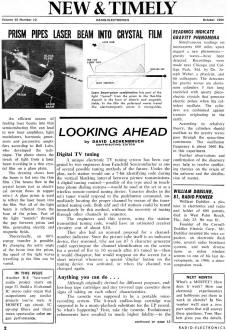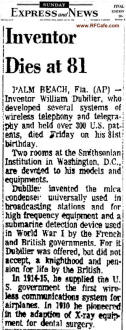William Dubilier, Radio Pioneer, Dies |
|
William Dublier, Radio Pioneer, Dies
Founder of the Cornell-Dubilier Electric Corporation, Mr. Dubilier invented the mica capacitor, an electronic flash tube, several radio broadcast systems, and such diverse items as nylon window screens to one of his last developments, in 1966, a sinus-congestion mask. Obituary from the Sunday, July 27, 1969 edition of the San Antonio Express and News newspaper:
Palm Beach, Fla. (AP) - Inventor William Dubilier, who developed several systems of wireless telephony and telegraphy and held over 300 U.S. patents, died Friday on his 81st birthday. Two rooms at the Smithsonian Institution in Washington, D.C., are devoted to his models and equipments. Dubilier invented the mica condenser universally used in broadcasting stations and for high frequency equipment and a submarine detection device used in World War I by the French and British governments. For it Dublilier was offered, but did not accept, a knighthood and pension for life by the British. In 1914-15, he supplied the U.S. government the first wireless communications system for airplanes. In 1910 he pioneered in the adaption of X-ray equipment for dental surgery.
Posted November 16, 2018 |
|



